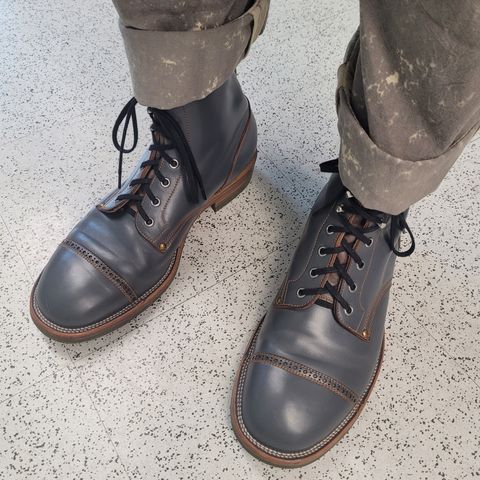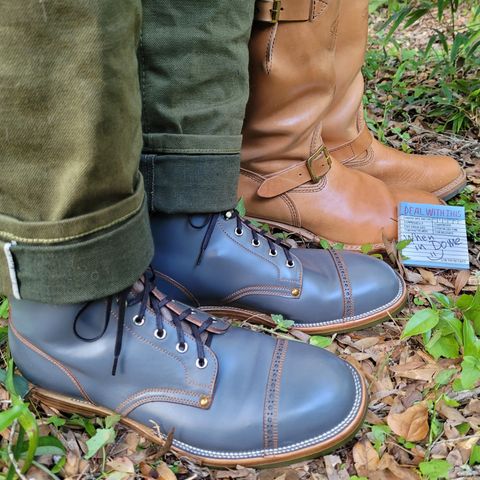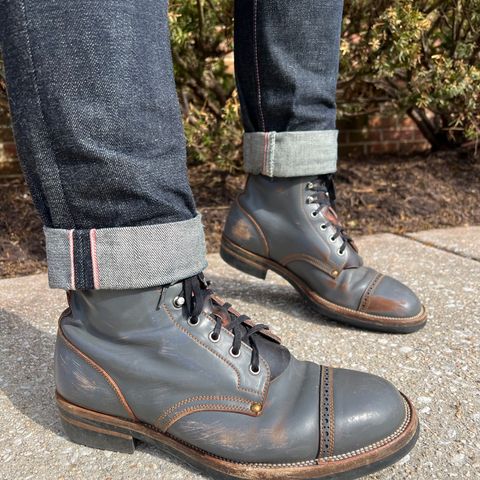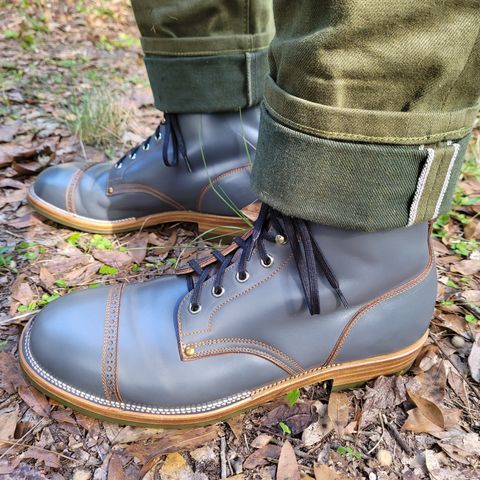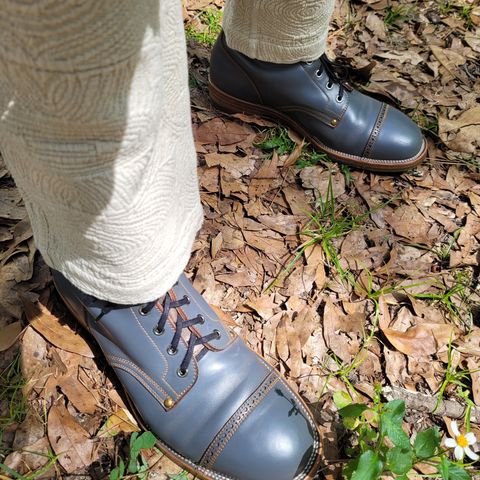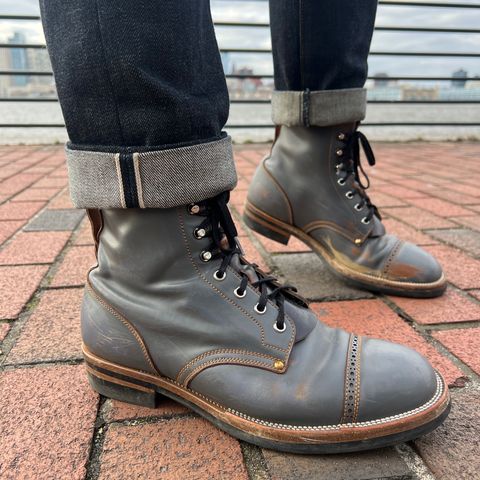About
Maryam Classico Shell Cordovan is a vegetable-tanned leather produced by Maryam Tannery in Santa Croce sull'Arno, Tuscany, Italy. Made from the flat fibrous muscle beneath the skin on a horse's rump, this leather represents the Classico line's approach to shell cordovan production, featuring surface-only coloring and traditional Italian tanning methods that have been refined over generations.
About
Maryam Classico Shell Cordovan is a vegetable-tanned leather produced by Maryam Tannery in Santa Croce sull'Arno, Tuscany, Italy. Made from the flat fibrous muscle beneath the skin on a horse's rump, this leather represents the Classico line's approach to shell cordovan production, featuring surface-only coloring and traditional Italian tanning methods that have been refined over generations.
The leather is produced using ancient Tuscan Vacchetta tanning techniques with Sego (tallow) oiling, a process that takes at least nine months to complete. Maryam's shell cordovan exhibits high density and microscopic porosity, making it naturally water resistant while maintaining the characteristic ability to roll rather than crease. Each piece varies due to the handcrafted production process, with colors varying between individual skins.
Located in one of Europe's largest tanning districts, Maryam Tannery produces shell cordovan that develops patina over time, making it particularly valued in heritage footwear applications. The Classico line is available in multiple color variants including brown and grigio (grey), serving the specialized market of premium bootmakers and heritage footwear enthusiasts.
History and Origin
Shell cordovan takes its name from the city of Cordoba, Spain, where it was first produced by the Visigoths in the seventh century. The leather subsequently spread to countries in northern Africa before becoming associated with high-quality European leather production. Scientifically, cordovan is more similar to cartilage than traditional leather, as it comes exclusively from the subcutaneous membrane of horse hides.
Between the nineteenth and early twentieth centuries, shell cordovan was primarily used for sharpening barbers' razors due to its dense, smooth surface. The transition to footwear and luxury goods applications occurred more recently, with the material gaining recognition for its durability and aging characteristics in the modern heritage footwear market.
Production Process
Maryam Tannery's production of shell cordovan follows traditional methods that have been passed down through generations in the Santa Croce sull'Arno tanning district. The process begins with the careful selection and preparation of horse hides, focusing specifically on the shell - the flat fibrous muscle located beneath the skin on the horse's rump.
The tanning process employs ancient Tuscan Vacchetta techniques combined with Sego (tallow) oiling, which makes the resulting leather particularly beautiful, resistant, and pleasant to touch. This vegetable tanning process uses 100% natural products without heavy metals, taking a minimum of nine months to complete and sometimes extending longer depending on the specific requirements of each hide.
Production involves meticulous hand tanning, glazing, and hand-finishing by skilled craftsmen who carefully strip the leather from the flesh side to reveal the shell cordovan. The color is applied by hand in multiple phases to ensure uniform penetration, followed by additional hand lubrication and glass polishing to achieve transparency and surface quality of the finished product.
The process combines centuries-old experience with modern technologies and equipment, allowing Maryam to maintain traditional quality standards while meeting contemporary production needs. Each hide undergoes careful transformation based on the slow passage of time and the use of natural tannins from trees, reflecting the tannery's commitment to preserving traditional Italian leather-making methods.
Properties and Characteristics
Maryam Classico Shell Cordovan exhibits several physical properties that distinguish it from other leather types. The material possesses high density and microscopic porosity, characteristics not visible to the naked eye but which contribute to its durability, suppleness, and natural water resistance.
The leather demonstrates depth and sheen, accompanied by a resistant grain and smell that maintains these qualities over time. Unlike conventional leather that creases when bent, shell cordovan's tight grain structure causes it to roll, preventing the formation of permanent crease lines that can weaken other leather types.
With a density 8 to 10 times greater than calfskin leather, shell cordovan retains waxes and oils much longer than conventional materials. This density contributes to its longevity while requiring less frequent conditioning than other premium leathers. The average thickness of Maryam's shell cordovan is 1.8mm (4-5 oz), with a semi-gloss finish that provides an aniline effect.
Each piece of shell cordovan varies, with natural variations in color and characteristics due to the handcrafted production process. Small natural marks such as skin pores may be present, and colors are never 100% identical between individual pieces, reflecting the artisanal nature of the production process.
Classico Line
The Classico line represents Maryam's approach to shell cordovan production, characterized by surface-only coloring rather than through-dyeing methods. This "classic article" approach allows the natural characteristics of the shell cordovan to show through while providing color variation in the final product.
The Classico line is available in multiple color variants, with brown and grigio (grey) being among the documented options. The surface coloring technique allows for consistent color application while preserving the underlying qualities of the shell cordovan, including its natural grain structure and aging characteristics.
Each piece in the Classico line maintains the variability inherent to handcrafted leather production, with individual skins displaying varied color depth and characteristics. This variation is considered a desirable feature rather than a defect, reflecting the artisanal production methods employed by the tannery.
Care and Maintenance
Shell cordovan requires minimal care compared to other premium leathers due to its high oil content and dense structure. The recommended conditioning frequency is every 10 to 15 wears, significantly less than the after-each-use conditioning required by many other leather types.
Basic care involves cleaning with a soft, damp cloth, allowing the leather to dry completely away from heat sources and moving air, then brushing vigorously for several minutes using a horsehair brush. This brushing action helps maintain the leather's natural oils and surface characteristics.
When conditioning is necessary, a light application of neutral creme cordovan or Venetian cream should be applied sparingly, allowing it to sit for at least 10 minutes or overnight before buffing. The leather should be kept away from direct sunlight and heat sources to prevent drying and color fading, and contact with oily substances should be limited as they can create permanent spots.
The dense structure of shell cordovan makes it remarkably resilient, with even 50-year-old pieces capable of restoration through proper cleaning and conditioning. This durability, combined with minimal care requirements, makes shell cordovan particularly suitable for heritage footwear applications where longevity is valued.
Aging and Patina
Shell cordovan develops a particularly pleasant patina over time due to its vegetable tanning process and natural oil content. The aging process creates patterns based on individual use patterns and environmental exposure, with each piece developing its own character.
Natural shell cordovan can develop orange tones with significant wear and UV exposure, creating a gradient effect that varies across different areas of the leather. This color migration occurs naturally through the combination of oil movement and UV fading, processes that are considered desirable aging characteristics rather than defects.
The patina development in shell cordovan is notably different from other leathers due to its dense structure and grain characteristics. Rather than simply darkening or lightening uniformly, shell cordovan develops complex color variations that reflect the specific stresses and environmental conditions it encounters during use.
The vegetable tanning process contributes to the leather's ability to age gracefully, with the natural tannins allowing for continued evolution of color and character over decades of use. This aging process is particularly valued in heritage footwear applications, where the development of patina is considered an essential aspect of the leather's appeal.
Usage in Heritage Footwear
Shell cordovan is commonly used in high-end shoemaking and bootmaking, though its rugged characteristics make it particularly well-suited for casual styles rather than elegant formal footwear. The material's durability and properties have made it a suitable choice for heritage work boots and casual footwear styles.
The small size of individual shells presents challenges for footwear production, with each shell measuring approximately 2 square feet compared to 20-25 square feet for conventional side leather. This limitation often means that a single shell is not sufficient to construct a complete pair of shoes, requiring careful planning and efficient use of the available material.
Heritage bootmakers value shell cordovan for its ability to withstand heavy use while developing attractive aging characteristics. The leather's resistance to creasing and its natural water resistance make it particularly suitable for boots intended for regular wear in challenging conditions.
The properties of shell cordovan have made it increasingly popular in the European fashion markets over the past decade, with heritage bootmakers and high-end shoe manufacturers incorporating it into their premium offerings. Its combination of durability, aging characteristics, and traditional production methods aligns with the values emphasized in contemporary heritage footwear.
References
Maryam Tannery. "Shell Cordovan Production". Conceria Maryam Official Website. Retrieved September 24, 2025.
Maryam Tannery. "Shell Cordovan Classico". Conceria Maryam Product Page. Retrieved September 24, 2025.
Buy Leather Online. "Shell Cordovan Leather – Maryam Tannery". Leather Distributor Product Information. Retrieved September 24, 2025.
The Silk Road Magazine. "MARYAM Ancient vegetable tannery…and metal free". February 23, 2022.
The Tannery Row. "Shell Cordovan Leather FAQs". Leather Educational Content. Retrieved September 24, 2025.
Guarded Goods. "Shell Cordovan Leather: A Legendary Material for Footwear and Leather Goods". Manufacturer Educational Content. Retrieved September 24, 2025.
Iron Boots. "Maryam Grigio Shell Cordovan The Chosen One". Retailer Product Page. Retrieved September 24, 2025.
Gentleman's Gazette. "Shell Cordovan Leather, Explained". Style Publication Educational Content. Retrieved September 24, 2025.
The Elegant Oxford. "Shell Cordovan: Everything you need to know". Footwear Educational Website. Retrieved September 24, 2025.
Horween Leather Company. "Shell Cordovan Care". April 6, 2018.
Craft and Antler Co. "Guide to Caring for Shell Cordovan Leather". Leather Care Guide. Retrieved September 24, 2025.
Ashland Leather. "What is Shell Cordovan?". Educational Content. Retrieved September 24, 2025.
